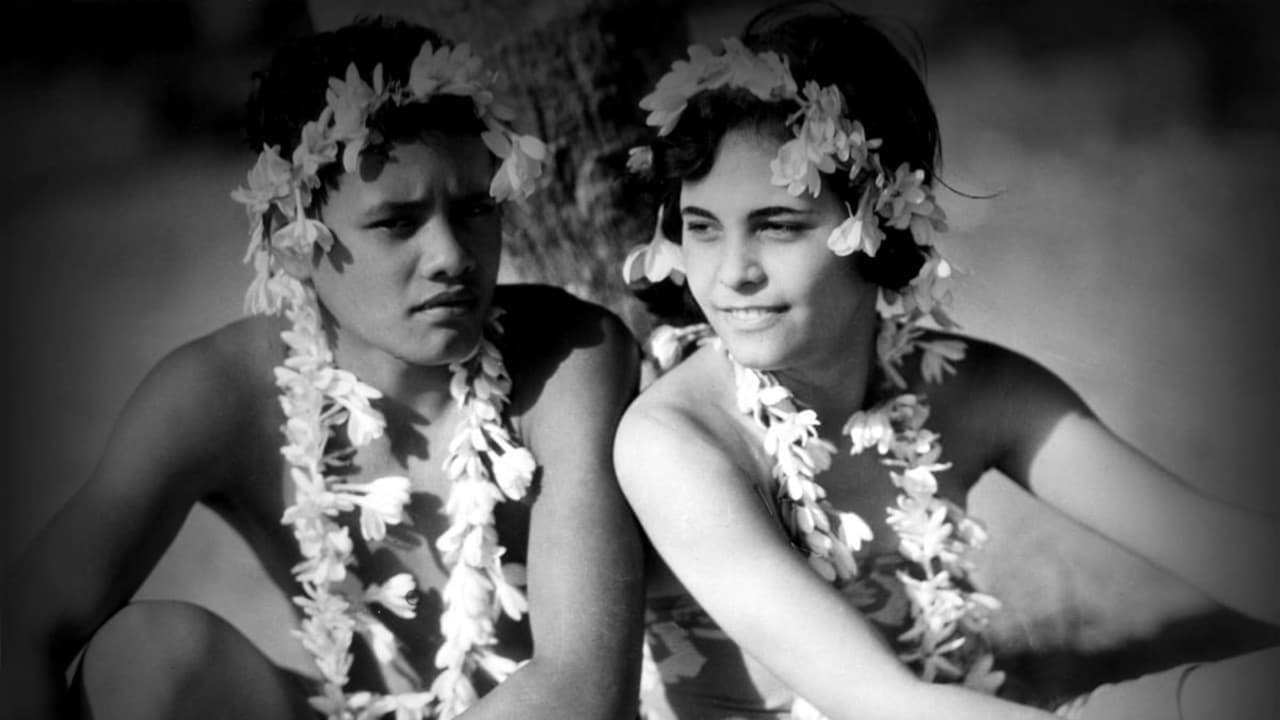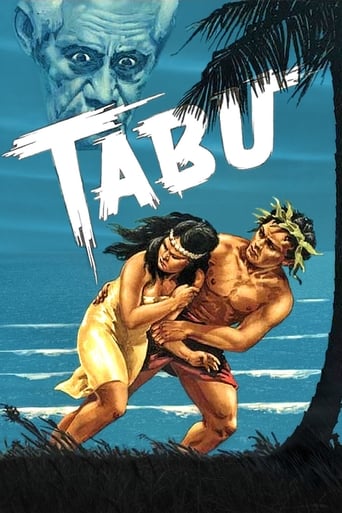

Floyd Crosby's superb cinematography won him a richly deserved Oscar for F.W. Murnau's "Tabu". The film itself is a very simple, perhaps even simplistic. love story of the kind we have become accustomed to hearing since love stories first were told; boy loves girl, girl loves boy but they can't be together because, in this case, the girl is decreed to be a sacred virgin by the island chief.The subtitle of the film is 'A Story of the South Seas' and Murnau, together with Robert Flaherty, made the film on the island of Bora Bora. There are very few inter-titles so the film is, for the most part, a truly visual experience. The cast is made up entirely of non-professionals; the leads are native islanders and if often feels like a documentary rather than a work of fiction. Of course, it also feels as primitive as the lifestyle it portrays; sophistication is the one thing it lacks but perhaps that is not such a bad thing. Fundamentally this is a tale of innocence and of paradise lost and it has stood the test of time.
... View MoreA tale of forbidden love, TABU is best-remembered today as legendary German director FW Murnau's last film - he was killed in a car accident only one week before its New York premiere. Murnau had been working in Hollywood since the mid-1920s, and had already directed several films in the United States, but of these, only the famous SUNRISE (1927) was a success. By 1930, Murnau had become tired of the Hollywood system and was thinking about returning to Germany, but a timely introduction to Robert F. Flaherty - at that time famous as the director of the classic documentary NANOOK OF THE NORTH - sparked an ill-fated collaboration that resulted in this gorgeous, hypnotic and unforgettable film.At first, Murnau and Flaherty intended to produce a "Nanook-style" documentary of Tahiti and its people, but several problems intervened: Flaherty and Murnau turned out to have radically different ideas about film-making in general and this project in particular; Flaherty's skills as a cinematographer were not up to the task and another DP had to be called in; and Flaherty's working relationship with the domineering Murnau fell apart when - instead of being co-director as the two had agreed - Flaherty found himself spending most of his time in the lab developing Muranu's film. Only one scene directed by Flaherty remains in TABU - the opening spearfishing sequence - and sad to say, the quality of this scene is no match for Murnau's exquisite footage. In addition, Flaherty decided that he hated the story - he found it too Westernized and fairy-tale-like. After a period of mutual discontent, Murnau bought out Flaherty, sent the entire Hollywood crew back to California, and took over the project completely - even training Tahitian natives in film-making techniques so he could employ the locals as his crew. With the exception of Anne Chevalier - a local French/Tahitian woman whom Murnau discovered performing in a bar in Bora Bora - the entire cast and crew save Murnau and his cinematographer was made up of nonprofessionals.The film which resulted from this choice is a unique hybrid of documentary and fiction, with a mythic, fantasmatic air about it that is very hard to define - there is no other movie like TABU. Certainly, the fact that we are watching actual Tahitian natives going about their daily business rather than professional actors lends the film a patina of authenticity and realism which makes it impossible to categorize TABU as some sort of Western-colonial-white people's fantasy of the South Seas - in fact, the film's depiction of tribal culture is quite complex and thought-provoking, as we will see...The plot of TABU is diagramatically simple - the idyllic lives of a Bora Bora fisherman (called Matahi) and his beloved, Reri (Anne Chevalier) are destroyed when tribal elders decree that Reri is so perfect a specimen of local womanhood that the gods have selected her for the honor of becoming their sacrificial victim. Reri immediately becomes TABU - forbidden - to Matahi as she must come before the gods untouched by man. Not surprisingly, Matahi disagrees with the gods' choice. He kidnaps Reri and the two flee to a neighboring island where they believe they will be safe. Unfortunately, this particular island has been taken over by Western civilization and thus the innocent Matahi and Reri have to navigate some very unfamiliar and peculiar customs - like debt and credit. Matahi begins working as a pearl diver, but he is unable to understand money (or handle liquor) and is threatened with violence when he cannot repay a debt. The couple flee once more, desperate for a safe haven, but they do not find one. Matahi and Reri's lives become more and more insecure and in due course of time, the tribal elders track them down anyway. Realizing that the only choice they have is to return to the world they know, Reri resigns herself to her fate, but will Matahi accept the inevitable? A mere plot-summary cannot fully express what TABU is like as a visual and intellectual experience. The film's treatment of native culture is extremely complex - unlike the "noble savage" cliché so popular among Western audiences and seen most recently in AVATAR, Murnau's Bora Bora seems like Eden on the surface, but is governed by a rigid code of conduct which squashes individuality and personality. Matahi and Reri's innocent love is doomed from the beginning, as they are caught between two worlds and unable to find a place in either. Ultimately, the beauty and simplicity of tribal life in Bora Bora - so seductive to the eye and ear in the first part of the film - is shown to be a soul-destroying deathtrap governed by superstition and groupthink. Of course, Murnau depicts the Western system as being no better - European civilization is shown as not much more than drunken, greedy, exploitative artifice out to rape the entire world for a fast buck. TABU is in many ways a terrifying film, where pure love is doomed in the face of money and authority, and even the gorgeous purity of the Tahitian Islands seems tainted by human greed and foolishness. This masterpiece will haunt you for a long time after you have seen it, partly because of the riveting story, and partly because of the exquisite cinematography by Floyd Crosby, who deservedly won an Academy Award for his efforts. Do not miss this legendary masterwork of cinema!
... View MoreMonday March 22, 7pm, The Paramount, Seattle"I will come to you in your dreams when the moon spreads its path on the sea"Tahitian lovers flee their island home to escape a royal edict. Chosen as a sacred maiden, the girl is tabu. "Man must not touch her, or cast upon her the eye of desire." They struggle to survive in an unfamiliar world while their fate slowly closes in.F. W. Murnau set sail for Bora Bora in 1929 to produce what would be his last film. He quickly lost his financing, alienated his co-writer Robert Flaherty, and was forced to bankroll the project himself. The end result was a lyrical vision of naked youth and forbidden romance amid warm trade winds and glittering tropical waters.Released in 1931, well beyond what is generally considered the end of Hollywood's silent-era, Tabu was produced as a silent film with a synchronized score. It differs from actual silent era films with synchronized musical/sound-effects scores in that it survives virtually unknown without its RCA-Photophone soundtrack.
... View MoreThis is a great film, one that actually benefits from being silent. The south-seas love story could seem incredibly hackneyed, but the sensitive silent presentation makes it all seem believable. Flaherty's painstaking ethnographic research pays off, establishing that we are getting a genuine look at Polynesian village life. The roles are played by actual villagers under their own names.This was originally going to be a documentary like Nanook of the North, but Murnau got so fascinated by Polynesian legends told by the locals that he decided to incorporate them into the story. This also meant that he had to invest his own money in the film, as Hollywood would have none of it. Nowadays we think anything so beautiful couldn't be genuine, but Murnau and Flaherty seem to have constructed an accurate document.The tragic love story has its parallel in real life, as Murnau was killed in a car-crash days after the film's completion.The MTV generation is better able to appreciate silent films than the 60's crowd, so I recommend to viewers interested in something different.
... View More